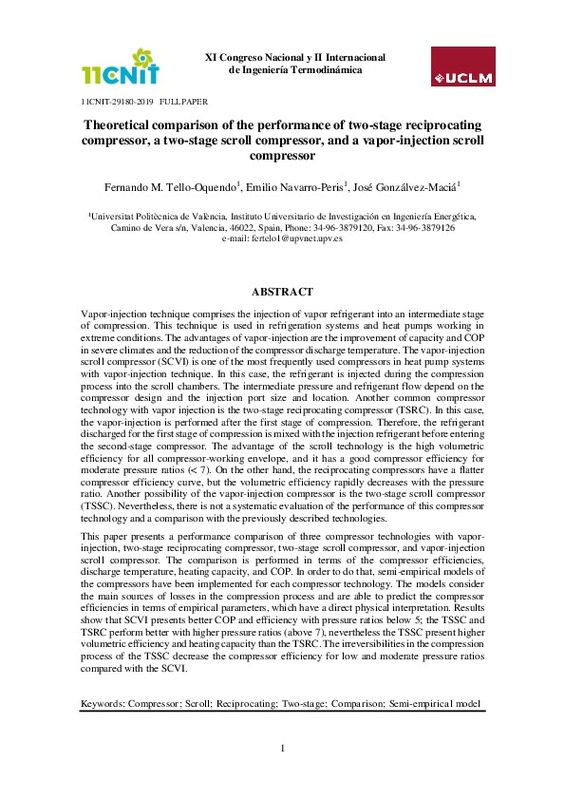Tello-Oquendo, FM.; Navarro-Peris, E.; Gonzálvez-Maciá, J. (2019). Theoretical comparison of the performance of two-stage reciprocating compressor, a two-stage scroll compressor, and a vapor-injection scroll compressor. Universidad de Castilla-La Mancha
José Antonio Almendros Ibáñez. 1-12. http://hdl.handle.net/10251/180686
Por favor, use este identificador para citar o enlazar este ítem: http://hdl.handle.net/10251/180686
|
Título:
|
Theoretical comparison of the performance of two-stage reciprocating compressor, a two-stage scroll compressor, and a vapor-injection scroll compressor
|
|
Autor:
|
Tello-Oquendo, Fernando M.

 Navarro-Peris, Emilio
Navarro-Peris, Emilio

 Gonzálvez-Maciá, José
Gonzálvez-Maciá, José
|
|
Entidad UPV:
|
Universitat Politècnica de València. Departamento de Termodinámica Aplicada - Departament de Termodinàmica Aplicada
Universitat Politècnica de València. Instituto de Ingeniería Energética - Institut d'Enginyeria Energètica
|
|
Fecha difusión:
|
|
|
Resumen:
|
[EN] Vapor-injection technique comprises the injection of vapor refrigerant into an intermediate stage
of compression. This technique is used in refrigeration systems and heat pumps working in
extreme conditions. The ...[+]
[EN] Vapor-injection technique comprises the injection of vapor refrigerant into an intermediate stage
of compression. This technique is used in refrigeration systems and heat pumps working in
extreme conditions. The advantages of vapor-injection are the improvement of capacity and COP
in severe climates and the reduction of the compressor discharge temperature. The vapor-injection
scroll compressor (SCVI) is one of the most frequently used compressors in heat pump systems
with vapor-injection technique. In this case, the refrigerant is injected during the compression
process into the scroll chambers. The intermediate pressure and refrigerant flow depend on the
compressor design and the injection port size and location. Another common compressor
technology with vapor injection is the two-stage reciprocating compressor (TSRC). In this case,
the vapor-injection is performed after the first stage of compression. Therefore, the refrigerant
discharged for the first stage of compression is mixed with the injection refrigerant before entering
the second-stage compressor. The advantage of the scroll technology is the high volumetric
efficiency for all compressor-working envelope, and it has a good compressor efficiency for
moderate pressure ratios (< 7). On the other hand, the reciprocating compressors have a flatter
compressor efficiency curve, but the volumetric efficiency rapidly decreases with the pressure
ratio. Another possibility of the vapor-injection compressor is the two-stage scroll compressor
(TSSC). Nevertheless, there is not a systematic evaluation of the performance of this compressor
technology and a comparison with the previously described technologies.
This paper presents a performance comparison of three compressor technologies with vaporinjection, two-stage reciprocating compressor, two-stage scroll compressor, and vapor-injection
scroll compressor. The comparison is performed in terms of the compressor efficiencies,
discharge temperature, heating capacity, and COP. In order to do that, semi-empirical models of
the compressors have been implemented for each compressor technology. The models consider
the main sources of losses in the compression process and are able to predict the compressor
efficiencies in terms of empirical parameters, which have a direct physical interpretation. Results
show that SCVI presents better COP and efficiency with pressure ratios below 5; the TSSC and
TSRC perform better with higher pressure ratios (above 7), nevertheless the TSSC present higher
volumetric efficiency and heating capacity than the TSRC. The irreversibilities in the compression
process of the TSSC decrease the compressor efficiency for low and moderate pressure ratios
compared with the SCVI.
[-]
|
|
Palabras clave:
|
Compressor
,
Scroll
,
Reciprocating
,
Two-stage
,
Comparison
,
Semi-empirical model
|
|
Derechos de uso:
|
Reserva de todos los derechos
|
|
ISBN:
|
978-84-09-11635-5
|
|
Fuente:
|
XI National and II International Engineering Thermodynamics Congress.
|
|
Editorial:
|
Universidad de Castilla-La Mancha
José Antonio Almendros Ibáñez
|
|
Versión del editor:
|
https://eventos.uclm.es/22532/detail/xi-congreso-nacional-y-ii-internacional-de-ingenieria-termodinamica-11-cnit.html
|
|
Título del congreso:
|
XI Congreso Nacional y II Internacional de Ingeniería Termodinámica (11-CNIT)
|
|
Lugar del congreso:
|
Albacete, Spain
|
|
Fecha congreso:
|
Junio 12-14,2019
|
|
Código del Proyecto:
|
info:eu-repo/grantAgreement/AEI/Plan Estatal de Investigación Científica y Técnica y de Innovación 2013-2016/ENE2017-83665-C2-1-P/ES/MAXIMIZACION DE LA EFICIENCIA Y MINIMIZACION DEL IMPACTO AMBIENTAL DE BOMBAS DE CALOR PARA LA DESCARBONIZACION DE LA CALEFACCION%2FACS EN LOS EDIFICIOS DE CONSUMO CASI NULO/
info:eu-repo/grantAgreement/SENESCYT//2015-AR37665/
|
|
Agradecimientos:
|
Fernando M. Tello-Oquendo acknowledges the financial support provided by the
CONVOCATORIA ABIERTA 2013-SEGUNDA FASE program, which was funded by the
SENESCYT (Secretaría de Educación Superior, Ciencia, Tecnología e Innovación) ...[+]
Fernando M. Tello-Oquendo acknowledges the financial support provided by the
CONVOCATORIA ABIERTA 2013-SEGUNDA FASE program, which was funded by the
SENESCYT (Secretaría de Educación Superior, Ciencia, Tecnología e Innovación) (Grant No
2015-AR37665) of Ecuador. The authors acknowledge the Spanish MINISTERIO DE
ECONOMIA Y COMPETITIVIDAD, through the project ref-ENE2017-83665-C2-1-P
Maximización de la eficiencia y minimización del impacto ambiental de bombas de calor para
la descarbonización de la calefacción/ACS en los edificios de consumo casi nulo for the given
support.
[-]
|
|
Tipo:
|
Comunicación en congreso
Capítulo de libro
|







